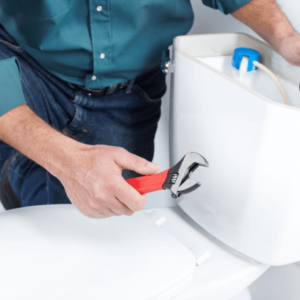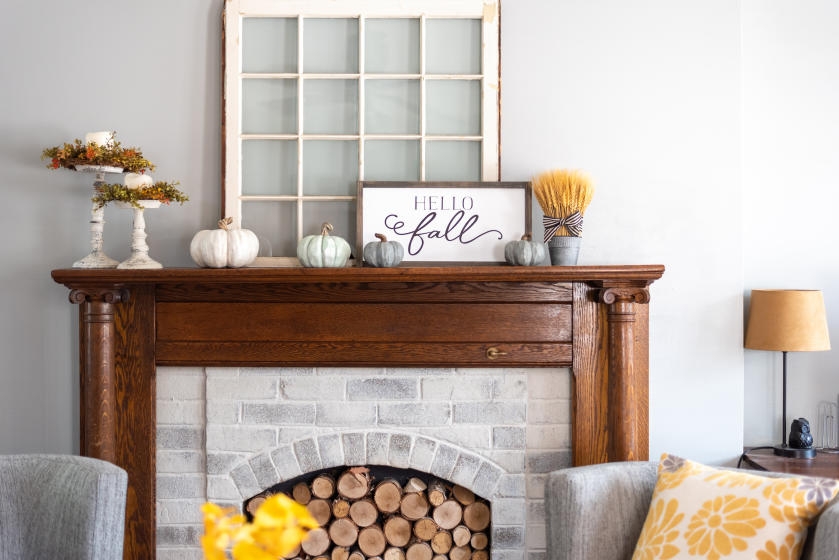Before central heating, a home’s fireplace was traditionally a point of congregation for warmth and quality family time. Even if you don’t use your fireplace that often, the fireplace mantel still is a focal point in many living rooms today. Keep yours beautiful and bring the room together by restoring your wood mantel to its former glory this weekend.
Step 1: Prep for Fireplace Restoration
The first step is to prepare the work area. Remove any adjacent furniture from around the mantel. Clear the mantel of any accessories and take down any artwork, mirrors, etc. that may be hung above it. Remove nearby fixtures, window coverings, switch plates or outlet covers, or protect them with painter’s tape. Place drop cloths around the base of the mantel and secure them to the floor with painter’s tape to protect the floor from dust, debris and potential stain or paint splatter later on.
Inspect the fireplace mantel for any cracks, nicks or gouges. If they are too large to remove with sanding, fill them with wood putty. Remove excess putty with a rag, but don’t worry about putty that protrudes from the imperfection as it can be smoothed out by sanding after it dries. Let the putty set for the recommended time indicated by the manufacturer. If your mantel has a veneer on top, see next step.
Step 2: Repair Veneer (Optional)
While some mantels are made of solid hardwood, others consist of a thin veneer glued on top of a less expensive base material. These give the appearance of solid wood — unless the veneer becomes damaged or the glue fails and causes the edges to separate or the interior to bubble.
To repair a bubble, carefully slit it in a straight line following the grain using a utility knife or razor blade. Soften the glue by heating the surface with a blow dryer or by placing craft paper or brown paper bags over the surface and pressing with a household iron, set to low heat. When the glue becomes tacky, press the area flat with a veneer roller or wallpaper seam roller. Be sure to work quickly, before the glue cools.
Helpful Tip
To avoid overheating and softening adjacent veneer surfaces, heat only a small area at a time and press down frequently to check for tackiness. Stop heating as soon as the glue feels soft.
If heat doesn’t work, you’ll have to re-glue. Start by slitting an elongated X through the bubble, following the grain as much as possible. Use a utility knife or sharp wood chisel to scrape off any old glue between the substrate and back of the veneer. Now add a fresh coat of yellow wood glue and remove any excess with a damp cloth. Place a piece of wax paper on top and cover with a heavy weight, such as a phone book. Allow to set for at least an hour.
Helpful Tip
If the veneer has peeled away from the edge, use the same techniques noted above, but don’t slit the veneer.
Step 3: Remove Old Finish
If your mantel is stained wood, you need to remove the old finish so you can add new coats of stain. If your mantel is painted, there is no need to remove the existing finish completely if you’re just going to repaint it, but you do need to sand it so that the new paint finish will adhere better.
You can remove the existing finish with either sandpaper or a chemical stripper, or a combination of both. Use a medium-grit sandpaper or sanding sponge to sand off the old finish and smooth out any imperfections in the wood. Sand carefully around any decorative details and curved areas. Always sand with the grain of the wood. Any swirl marks caused by sanding will stand out when you stain. Repeat the process with a medium/low-grit or low-grit sandpaper. Use a tack cloth to remove sanding dust.
Using a chemical stripper is probably the easiest method for refinishing a mantel. Depending on the kind of stripper you use, apply it with a clean cloth or paintbrush, or spray it directly onto the wood. It will begin eating away at the old finish almost immediately. Use a paint scraper, sponge or a rag to wipe off the old stain. Once you’ve removed the old finish from the surface, use a clean rag to wipe down the surface so that the wood is completely bare. Let it dry.
Safety Alerts!
Always follow manufacturer’s instructions and wear rubber gloves and protective goggles when using strong chemicals.
Never strip furniture near an open flame as stripping chemicals can ignite.
Open windows and doors to keep the room well ventilated.
If you use a chemical stripper to remove the old finish, it’s a good idea to lightly sand the surface afterwards with fine-grit sandpaper. This will ensure a tighter bond between the wood and the new coats of stain. Then use water, mild detergent and a sponge to clean the entire surface of the mantel. Let it dry before continuing.
Step 4: Prep Mantel Surface for Finishing
If you will be re-staining your mantel, you should apply sanding sealer to the now bare wood. This is similar to priming the surface before painting. The sealer helps the wood absorb the stain evenly. It can also be applied after staining to reduce the number of finish coats necessary. Shake the sealer container thoroughly and apply two thin coats using a small paintbrush. Don’t let the sealer puddle or fill in decorative grooves. Wipe off any excess sealant with a clean cloth. Let the sealer dry completely before lightly sanding with medium-grit sandpaper in the direction of the grain. Wipe the wood again with a clean cloth to remove dust and residue.
If you will be painting your mantel, use a paintbrush to apply a coat of True Value EasyCare Ultra Premium Interior Primer/Sealer. Allow the primer to dry for up to 2 hours, or for as long as recommended by the primer label instructions. Feel the furniture’s surface for any rough spots and sand lightly if necessary. Apply a second coat. Let this coat dry for approximately 12 to 24 hours.
Step 5: Refinish Mantel

Apply a thin, even coat of Enrich interior varnish with a cloth or medium-sized paintbrush and allow it to penetrate into the wood. Coat once for a light stain or apply additional coats to create a darker color. Lightly sand between coats with fine-grit sandpaper. Wipe off excess stain with a clean cloth and allow the new mantel finish to dry completely.
Safety Alert!
Never refinish near an open flame as stains can ignite.
Helpful Tips
If you are using water-based stains, you can minimize raising the grain by moistening the wood with a damp cloth and sanding. Allow the wood to dry completely and sand lightly with fine-grit sandpaper. Repeat as necessary.
Do not use deck stain on interior wood surfaces such as your mantel.
You can think beyond “wood” and add color to your mantel by painting it. Consider your room’s existing color scheme when deciding on a paint color. Apply EasyCare Ultra Premium Interior Paint with a paintbrush. Brush it on with even strokes in the direction of the wood grain. Let it dry for the recommended amount of time and apply a second coat if need be.
Step 6: Clean Up
Pick up your drop cloths and close up your paint and varnish cans. Dispose of used paint, varnish or sealant cans appropriately. Cleaning paintbrushes and other tools can be made easy with warm and soapy water. Thoroughly rinse your roller covers and brushes in water (if you used latex paint) or paint thinner (for oil-based stain) until the solvent runs clear, then place them in a brush/roller spinner, if you have one, to remove excess liquid. Store in their protective sleeves or hang them on nails or hooks. Pick up drop cloths carefully, making sure you don’t spread around any paint or stain that may have gotten on them. Next, remove painter’s tape at a 45-degree angle to avoid removing any fresh finish. Remember that the longer it stays on, the harder it is to remove.
That’s it! Now you know how to restore your fireplace mantel.
Project Shopping List
Here’s what you’ll need to complete this project successfully.
- Painter’s tape
- Wood putty
- Drop cloths
- Utility knife or razor blade
- Blow dryer
- Craft paper or brown paper bags
- Clothes iron
- Veneer roller or wallpaper seam roller
- Sharp wood chisel
- Cloth
- Wax paper
- Pencil
- Wood glue
- C-clamp
- Enrich interior wood varnish
- Medium-grit sandpaper
- Medium/low-grit or low-grit sandpaper
- Tack cloth
- Chemical stripper
- Paint brush
- Rag
- Rubber gloves
- Protective goggles
- Mild detergent
- Sponge
- Sanding sealer
- EasyCare Ultra Premium Interior Primer/Sealer
- EasyCare Ultra Premium Interior Paint
- Fine-grit sandpaper
- Brush/roller spinner












